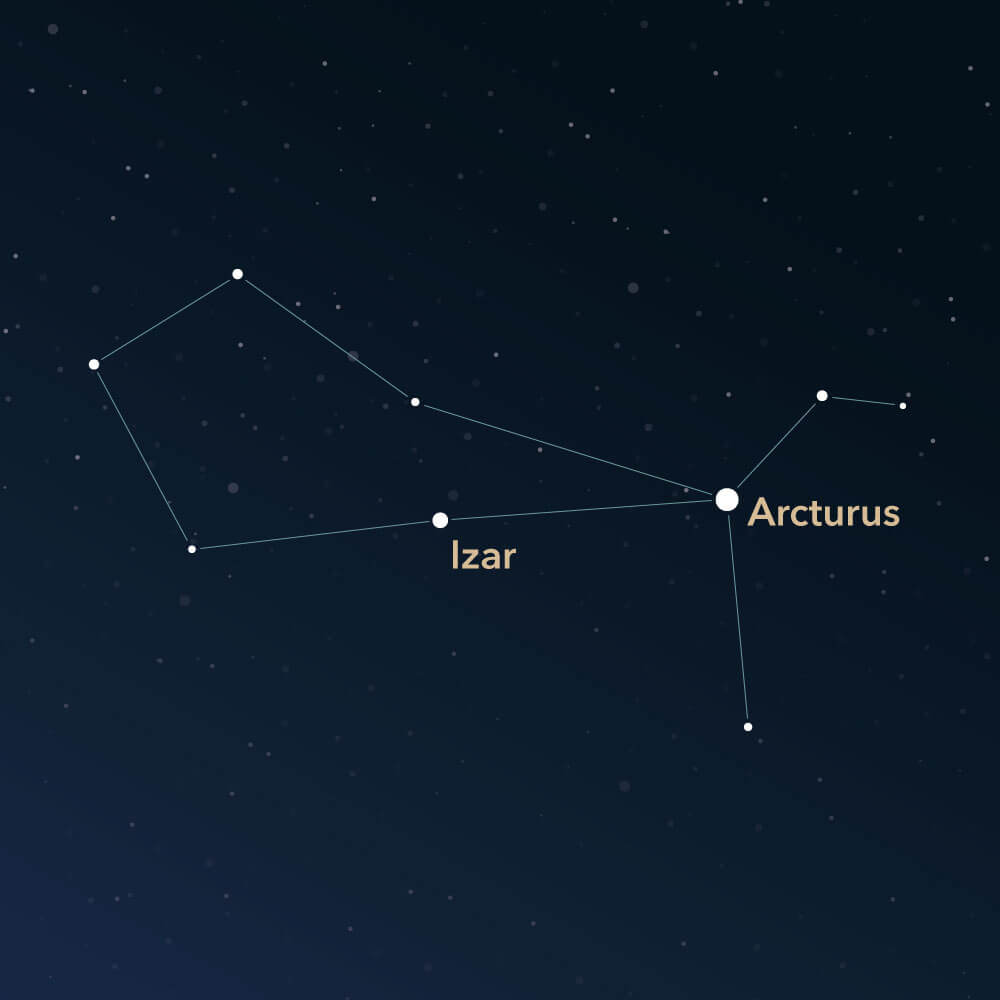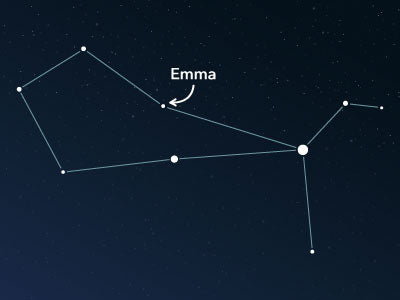The constellation Boötes
Características
- Nombre latino
- Boötes
- Hemisferio
- Hemisferio norte
- Visibilidad
- November - September
- Área
- 907 deg²
- Estrella más brillante
- Arcturus (HIP number 69673)
- Especialidades
- Many double-star systems, galaxies, globular cluster

Boötes (or Bootes), also named The Herdsman, is one of the 48 constellations described by the Greco-Roman astronomer Claudius Ptolemy in ancient times.
It is a prominent constellation in the northern night sky and is easy to locate due to its well-known neighboring constellations, such as Ursa Major or Virgo. There are many different versions of his story.
Hemisphere, visibility, and area
The constellation Boötes can be seen from all places located north of latitude 35° S, which means it is visible on the entire northern hemisphere. South of the equator, it is observable until locations such as Sydney in Australia or Santiago de Chile in Chile.
The northern region of the constellation is circumpolar, making it visible all year round. The best time to fully observe Boötes is between November and September.
Boötes stretches over the night sky with an area of 907 square degrees and is supposed to represent a man's figure, although it is often compared to a kite or an ice cream cone.
Eight neighboring constellations surround it. To the north lie both Draco and the well-known constellation Ursa Major. There are Canes Venatici, Coma Berenices, and Virgo to the east. To the south and west, the constellations Serpens (Caput), Corona Borealis, and Hercules border it.
Especially the neighboring constellation Ursa Major helps to locate Boötes in the night sky. By extending the handle stars of the Ursa Major with an imaginary line, one can spot the reddish star Arcturus (Latin: α Bootis, Alpha Bootis), the brightest star in the constellation Boötes.
Arcturus is not only the principal star of Boötes but also the brightest star in the northern hemisphere sky. It is visible worldwide (excluding Antarctica) and is likely the first star discovered with a telescope during daylight.
Together with the stars Regulus and Spica, it forms the Spring Triangle.
Specialties in the constellation
The area of Boötes contains an unusually high number of double stars.
Izar (Latin: ε Bootis, Epsilon Bootis) is one of the double-star systems in Boötes. It is located about 150 light-years away and appears in a telescope as a deep yellow star with a bluish star as its companion. This combination is often considered the most beautiful double-star system.
The triple system Mufrid (Latin: η Bootis, Eta Bootis) is also part of Boötes. It is about 55 light-years away from earth. Two stars are easily visible, while the third is somewhat fainter.
Other exciting deep-sky objects in Boötes include the galaxies NGC 5248 and NGC 5966 and the globular cluster NGC 5466.
The barred spiral galaxy NGC 5248 was discovered in April 1784 by the German-British astronomer William Herschel. Its distance from the Milky Way is about 50 million light-years, and its diameter is approximately 95,000 light-years.

NGC 5466 is one of the least massive globular clusters currently known. Because of its very low heavy element content, it is estimated to be very old.
Mythology and history
There are various approaches to the history and mythology of the constellation Boötes. While the visual representation of the strong man originates from the Middle Ages, the constellation's name has its roots in Roman-Greek antiquity.
Also, there are two different translations for the Latin name Boötes. In the classical interpretation, the strong man Boötes is the herdsman or driver of oxen who drives the oxen around the celestial pole with a plow. In the other conception, Boötes means shouter. Here he is the leader of the hunting dogs, who, with his roar, encourages the dogs to overpower the bear.
There are even three different versions of the stories about the history of the Boötes constellation.
The oldest ancient myth goes back to Philomelos. He is the son of Demeter, a Greek goddess responsible for the earth's fertility and, thus, for grain and seeds. In this approach, Philomelos is depicted as the inventor of the cart and the plow drawn by oxen.
In the stories of the poet Hesiod, Boötes is the illegitimate son of Zeus and the nymph Callisto, named Arcas. In revenge, Hera, the jealous wife of Zeus, turned Callisto into a bear who could not speak. Full of shame, Callisto withdrew into the forest, where her son Arcas later began to hunt.
Unknowingly, he also pursued his mother, the bear. To avoid a tragedy, though, Zeus intervened and placed both in the sky. The son Arcas as Boötes, and the mother Callisto as the Ursa Major.
The third version comes from the Roman writer Hyginus. He sees Icarius in the constellation, a diligent student of the wine god Dionysus. Dionysus taught Icarius how to make wine. Icarius was a hard-working student and soon made his own wine, which he proudly offered to some thirsty shepherds.
After the shepherds enjoyed the wine and experienced their first drunkenness unexpectedly, they assumed that Icarius wanted to poison them. Thereupon, they killed Icarius and buried his body under a tree.
Icarius loyal dog noticed this and later led Erigone, the unsuspecting daughter of Icarius, to the grave. After she discovered her dead father, she hung herself on the tree. The dog also sought death in a nearby well.
As a result, Zeus also placed the constellations of the Virgin and the Canis Minor in the sky.
PublicadoLeer más artículos interesantes

An overview of all 88 constellations
Learn more about all 88 constellations and read interesting information about the mythology, visibility, and features.

Planetario App
¡Descubre el cielo nocturno con nuestra aplicación de planetario!
Disponible para iOS y Android.

Nombrar una estrella en la constelación The Herdsman
Name a star in a constellation and create something that lasts for eternity.